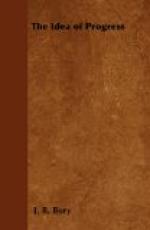The general atmosphere in France, in the reign of Louis XIV., was propitious to the cause of the Moderns. Men felt that it was a great age, comparable to the age of Augustus, and few would have preferred to have lived at any other time. Their literary artists, Corneille, and then Racine and Moliere, appealed so strongly to their taste that they could not assign to them any rank but the first. They were impatient of the claims to unattainable excellence advanced for the Greeks and Romans. “The ancients,” said Moliere, “are the ancients, we are the people of to-day.” This might be the motto of Descartes, and it probably expressed a very general feeling.
It was in 1687 that Charles Perrault—who is better remembered for his collection of fairy-tales than for the leading role which he played in this controversy—published his poem on “The Age of Louis the Great.” The enlightenment of the present age surpasses that of antiquity,—this is the theme.
La docte Antiquite dans toute sa duree
A l’egal de nos jours ne fut
point eclairee.
Perrault adopts a more polite attitude to “la belle antiquite” than Saint Sorlin, but his criticism is more insidious. Greek and Roman men of genius, he suggests, were all very well in their own times, and might be considered divine by our ancestors. But nowadays Plato is rather tiresome; and the “inimitable Homer” would have written a much better epic if he had lived in the reign of Louis the Great. The important passage, however, in the poem is that in which the permanent power of nature to produce men of equal talent in every age is affirmed.
A former les esprits comme a former les
corps
La Nature en tout temps fait les
mesmes efforts;
Son etre est immuable, et cette
force aisee
Dont elle produit tout ne s’est
point epuisee;
.....
De cette mesme main les forces infinies
Produisent en tout temps de semblables
genies.
The “Age of Louis the Great” was a brief declaration of faith. Perrault followed it up by a comprehensive work, his Comparison of the Ancients and the Moderns (Parallele des Anciens et des Modernes), which appeared in four parts during the following years (1688-1696). Art, eloquence, poetry the sciences, and their practical applications are all discussed at length; and the discussion is thrown into the form of conversations between an enthusiastic champion of the modern age, who conducts the debate, and a devotee of antiquity, who finds it difficult not to admit the arguments of his opponent, yet obstinately persists in his own views.




